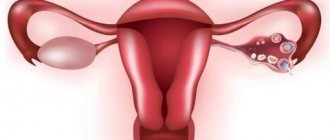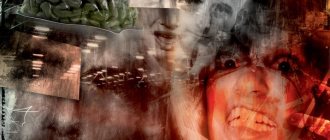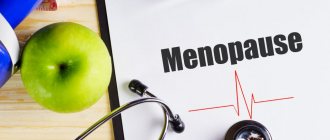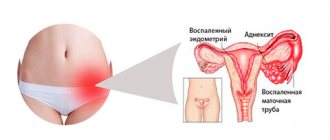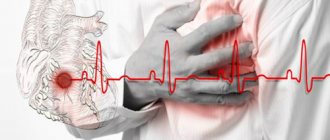Mental ill-being, an endogenous disease of the schizophrenia spectrum, a severe chronic illness leading to a disorder of mental activity - schizophrenia has been known to mankind throughout the history of existence. Despite this, diagnosis remains challenging. Not every psychotherapist is able to recognize the illness. The disease is characterized by significant clinical polymorphism. Schizophrenia changes a person’s behavior - that’s a fact. Worldwide, 1% of people are diagnosed, regardless of gender, race or continent. The rate may be higher due to true morbidity with mild or erased forms, which are not taken into account in official statistics.
Manifestation of symptoms
Schizophrenia symptoms and signs have three types: positive, negative and cognitive. They appear equally in both women and men. Some symptoms may be difficult to recognize as signs of mental illness. They look like laziness, depression, psychosis. If you look in more detail, the state of psychosis is indeed typical for people with this disease. Schizophrenia in women or men manifests itself at different ages. Schizophrenia in men from 15 to 35 years, and in women from 27 to 37 years.
Sluggish schizophrenia
The diagnosis of sluggish schizophrenia is considered mild; it is a mild form of the disease. It does not imply critical changes in a person’s character and his brain. Clinical symptoms increase very slowly, and the patient exhibits a complex of signs of neurotic disorders. This form of the disease is characterized by obsessive-compulsive disorder, various phobias, hypochondria, and paranoia.
Common symptoms:
- autism;
- scarcity of interests;
- selfishness;
- difficulties in contacts with others;
- the occurrence of hysterical attacks against a background of increased anxiety;
- suspicion.
Patients often experience causeless pessimism, which has no basis in real life. Many psychotherapist patients talk about attacks of sentimentality that they had never had before, self-doubt, and various fears. Often this condition is attributed to nervous tension and stress, but in fact it is a hidden symptom of a mental disorder.
Description of positive symptoms
Abnormal judgments and obsessions are noted at this stage. Schizophrenia causes a disorder of this kind against the will of the sick person. He can philosophize too much and conduct meaningless discussions on topics of an immense and global nature. The topic of conversation is often not only devoid of meaning, but also disordered in the style of narration, and there is a constant jumping from topic to topic. Positive signs of schizophrenia in women and men are accompanied by delusional states, motor and thinking disorders, and hallucinations.
What's next
Gradually, the sick male brain begins to draw its own picture of the world, to interpret what is happening in its own way.
The sufferer creates a new reality based on new sensations. Everything seems unreal to him; the feeling of altered consciousness, as if hypnotized, does not leave him. There is a hidden meaning, encrypted messages in everything. Walking down the street, a person witnesses a fight, and he becomes convinced that this performance was staged especially for him and carries hidden information. As the pathological process develops, the gradation of symptoms into positive and negative becomes more noticeable.
Negative symptoms of male schizophrenia include:
- isolation;
- avoidance of communication;
- emotionlessness;
- lack of will;
- apathy;
- neglect of personal hygiene.
Human behavior is changing more and more. Autistic traits are on the rise. A characteristic sign is loss of eye-to-eye contact.
Behavior is characterized by ambivalence, that is, duality: I want - I don’t want, I do - I don’t. A typical example. A schizophrenic comes to see a doctor. He extends his hand to say hello and abruptly pulls him away. Then he stretches it out again, withdraws it again, as if hesitating.
Problems in the cognitive sphere are growing sharply. Representatives of the stronger sex become absent-minded. Lost concentration. Perception and memory are impaired. Thinking is disorganized and illogical. As a result, the speech turns out to be difficult to understand, full of new words invented by the patient. Inferences are drawn incorrectly. A schizophrenic person thinks according to his own schemes, incomprehensible to others, which is why he seems absurd and insane to others.
It is worth noting that the basis of pathological thinking is not so much a violation of intelligence as a different perception of reality. A different picture of reality in the inner world of the male self, caused by changes in the psyche.
A number of psychiatrists believe: the later the disorder debuts, the more intact the intellect remains. Such individuals turn into real geniuses of science and art. They make incredible discoveries and become engines of progress. Scientists believe: such schizophrenics are simply a treasure for society and provide invaluable benefits. The mental abilities of schizophrenic geniuses are much higher than those of healthy non-geniuses.
There is a complete modification of one's own self. Sometimes people with schizophrenia themselves talk about themselves in the third person. The male personality is split into two. It’s as if two opposite people coexist in it: one does, the other criticizes. Gradually, there is a complete disintegration of the personality, in which it is already difficult to see the former one.
Unusual sensations in the body constantly accompany the patient. Complaints of headaches similar to migraines or brain tumors are typical. Headaches have a non-standard interpretation.
A man with schizophrenia claimed that his brain was increasing in size, swelling, filling all the space in the skull, pressing on the bones. The pressure is so great that your head is about to explode. The brain is so swollen that it hangs over the eyes, presses on the brow ridges, the eyelids - they protrude outward, the eyes will soon fly out of their sockets.
This syndrome even received a separate name: brain swelling.
Color perception also changes in schizophrenic disorder. Men are more likely to have a weakened reaction to color factors. Preference is given to a calm, muted palette, in contrast to women who prefer bright colors.
The color choice often depends on the form of the disease and the prevailing symptoms. For example, with the paranoid form, men gravitate toward blue and yellow colors. For depression, gray tones are chosen. The colors red and black have a stimulating effect on schizophrenics.
Description of negative symptoms
This group includes signs of schizophrenia with deeper emotional disorders. A person loses the ability to enjoy life. He falls into a depressed state or simply tries to protect himself from society. A neutral or bad mood is observed, but in rare cases the opposite manifestation occurs with an increase in mood. People with emotional disorders are not interested in the feelings of others. And they feel much more comfortable spending time alone. Schizophrenia manifests symptoms and signs of a negative type in the aspect of decreased sexual desire, ignoring hygiene rules, as well as alcohol consumption.
Description of cognitive symptoms
Cognitive signs are characterized by impairments in concentration and certain types of memory. A person cannot adequately plan, organize his own life, or make decisions. Schizophrenia exhibits symptoms and signs in the same way in women and men, but they are not always recognized as a medical history. It is possible to understand that these are disorders only with the help of neuropsychological tests. Schizophrenia can disguise symptoms as depression and psychosis. Tests allow you to find the truth.
Are you experiencing symptoms of schizophrenia?
Only a doctor can accurately diagnose the disease. Don't delay your consultation - call
Pharmacology and psychotherapy in the treatment of schizophrenic disorders
The first choice drugs are antipsychotics. These drugs have an antihalucinatory and sedative effect, are able to stop delusional and obsessive states, and return the patient to relative clarity of thinking. All antipsychotic drugs prescribed to a schizophrenic are taken in strict doses and exclusively under the supervision of the attending physician. For example, "Aminazine".
The drug is selected strictly according to the needs of each patient, the dose and duration of the course are adjusted during the recovery process. At the same time, psychotropic drugs of other groups are prescribed that affect the behavior, emotional stability and mood of a schizophrenic. We need corrective agents that reduce the level of anxiety, normalize sleep and help the patient return to the real world.
Psychiatrists work with schizophrenics, since this disease requires an extremely extensive knowledge base. You cannot trust the health of the sick person to psychologists, otherwise the situation will worsen and the personality will degrade irreversibly. The course of psychotherapy is indicated to take place in an inpatient psychiatric clinic.
The doctor’s task is not only to prevent the progression of the disease, but also to teach a man to independently recognize its phases and signs of exacerbation. Abstract-associative methods of work, hypnotic practices and deep psychoanalysis are strictly prohibited when working with such patients.
The patient must be able to critically assess his condition, distinguishing hallucinations from reality, correlate his actions with the emotional state of the people around him, and adequately express his desires.
Group cognitive behavioral or art therapy is best suited for these purposes. A psychiatrist can help with issues of social adaptation using occupational therapy methods.
Therapy should be comprehensive, including both medication and courses of psychiatric care. This is the only way to influence the processes occurring in the “sick” brain.
Psychiatric practice knows many examples when it was possible to achieve stable and long-term remission. If the disease is ignored, then personality changes will lead to chronic depression and, as a result, to possible suicide.
For more information about what schizophrenia is, watch the video:
This article has been verified by a current qualified physician, Victoria Druzhikina, and can be considered a reliable source of information for site users.
Rate how helpful this article was
4.8 4 people voted, average rating 4.8
Did you like the article? Save it to your wall so you don’t lose it!
What are the reasons for development
Schizophrenia does not occur due to one factor. We can say unequivocally that the disease is transmitted by heredity. If one of your close relatives has had such a diagnosis, it will most likely pass on to your children. And for this, the gender of the carriers does not matter. Having second-degree relatives (aunts, uncles, cousins, and grandparents) also increases the risk of receiving a diagnosis. In medical practice, identical twins are also monitored, where one of them has mental disorders. The risk for the second is 65%. In addition to the fact that schizophrenia is inherited by close relatives, it is necessary to take into account the influence of other factors. They can provoke a trigger in the body for the development of mental pathology:
- viral infections;
- stressful situations;
- social factors;
- antenatal infections;
- lack of vitamins.
Signs of schizophrenia
Official medicine finds it difficult to determine the exact causes that cause the development of schizophrenia. Long-term study of the mechanisms of the disease has not made it possible to identify specific stimuli for the deterioration of mental health. Somatic manifestations of the disease in childhood, adulthood and adolescence have significant differences. Therefore, a final diagnosis is possible only during the onset of puberty.
Among the most likely prerequisites for the development of a mental disorder, there are several main ones.
- Genetic predisposition.
The disease can be inherited from a close relative; approximately 10% of children in adolescence are diagnosed with this diagnosis if their mother or father has it.
- Hormonal dysfunction.
Schizophrenia is associated with impaired dopamine production. This hormone is a neurotransmitter that is responsible for the state of a person’s emotional sphere. If there is a pathology of the central nervous system, dopamine is produced in excess. At the physiological level, this causes intense mental overexcitation, in which a person constantly remains. The result is delusions, paranoid ideas, obsession, psychosis or hallucinations.
- The impact of viruses on the human body.
There is a category of pathogenic microorganisms that can destroy nerve cells. One of the most known pathological agents to science is the herpes virus. With good immunity, it can stay in the body for years without causing harm. If the patient suffers from various diseases of a chronic or infectious nature, viruses can manifest themselves, causing the manifestation of schizophrenia.
- Toxoplasmosis.
This is an indirect cause of the development of schizophrenia, but rather one of the risk factors. It is especially dangerous if a pregnant woman is infected: the fetus can develop pathologies, including diseases of the nervous system.
Common causes of schizophrenia include:
- alcohol, drug and other types of addiction;
- pathologies of intrauterine development;
- brain injuries that occurred during childbirth or throughout life;
- heredity;
- severe emotional shock;
- prolonged stay in a state of stress, prolonged depression.
Scientists believe that specific family attitudes are also the trigger for the development of the disease. Parents force the child to react to certain situations according to one scenario, while they themselves perform completely different actions. The dualistic attitude cannot be analyzed by a small child due to his age. Contradictions grow inside him, with which he is left alone. The constant search for answers to one's questions causes intrapersonal conflict, which over time can develop into a mental disorder.
Risk factors and complications
Signs of schizophrenia in men and women at different stages may not appear or periodically disappear. This is especially possible if treatment is followed. There are patients who lead normal professional and social lives, although this diagnosis is characterized by a desire to isolate themselves from society. Schizophrenia develops gradually in women and men over several years. Risk factors include the following conditions:
- suicide attempts (5-6% of patients commit suicide);
- alcohol abuse;
- outbursts of aggression;
- addiction.
Why do men get sick more often?
Statistics have given a verdict: the stronger sex suffers from schizophrenic disorder more often than the weaker. The fact of primacy is associated with various factors: high hopes are placed on the stronger sex, more claims are made against it, and many expectations are associated with it.
A man in the eyes of society is a protector, a provider, a support. If the stronger sex is the head of the family, the responsibility for providing for the family falls on his shoulders. The modern world poses the financial question quite harshly. To earn money, a representative of the strong half of humanity has to work hard. Physical and mental stress is classified as chronic stress, which is an important factor in provoking the disease.
Fun fact: bachelors are 4 times more likely to suffer from the disorder than married people.
Another reason for the prevalence of the disease among the male population of the planet is considered to be physical injuries, in particular to the head. Its representatives are fond of traumatic sports: boxing, karate. Women drive cars more intensively, becoming involved in accidents. They serve in the army and take part in hostilities. Banal yard fights are more common among boys. All this becomes an excellent breeding ground for brain damage. And then - depending on your luck.
Among men, alcohol abuse is more common; drugs poison the brain, causing severe intoxication.
Patients are able to put forward their theories and ways to resolve the disease.
A schizophrenic man claims: one of the provoking factors of the disease is pride. From childhood, the guy was proud, and also a braggart. He did not recognize God, and when he began to come to the atheist in visions and call him to himself, he fell into magic. He imagined himself to be the messiah, the savior of humanity. After treatment there was relief. I started going to church and reading the Bible.
An interesting theory about genius personalities. In literature you can often find the statement of the legendary psychiatrist Cesare Lombroso: genius and madness go hand in hand. Or the words of the great Aristotle that genius inevitably presupposes madness. And indeed: among the male population there are much more hidden geniuses than among the female population, which explains the higher frequency of male schizophrenia.
Main types of disease
In the medical classification, the main types of schizophrenia include 9 positions. Some of them have subtypes. Experts identify several of them, which occur most often. Paranoid schizophrenia manifests itself in increased suspicion of others. A person is haunted by the feeling that he is constantly being watched, he has delusions and hallucinations. In the catatonic form of the disease there are movement disorders. And this can be either complete immobilization or chaotic disorderly excitement. Simple schizophrenia does not have a history of acute psychosis, but negative symptoms increase over time. The hebephrenic form manifests itself in the form of dementia and foolishness.
Stages of schizophrenia
Psychiatrists distinguish 3 stages of the development of the disease.
- Mastery
The initial stage, which is characterized by a constant feeling of anxiety. Most often, the patient does not understand where it came from. The occurrence of obsessive thoughts leads to the fact that the patient constantly checks whether he has turned off the gas, locked the apartment, and turned off the iron. With the help of timely drug therapy, unpleasant symptoms are eliminated.
- addictive
The middle stage of development of the disease, which is accompanied by changes in the personality and consciousness of the patient. The real or fictional world is intertwined with each other, a schizophrenic cannot understand where is truth and where is fiction. The feeling of fear goes away over time, the patient perceives the current state of affairs as a given. This stage requires immediate treatment in a hospital.
- Regression
This is a severe stage of the development of schizophrenia, during which profound changes in a person’s emotional background are observed. The patient does not react in any way to surrounding events and people; he loses feelings of joy, sadness, shame and pleasure. The condition resembles dementia or dementia in old age. Logical thinking is completely absent, speech and motor functions are impaired. This stage is difficult to treat; to maintain the patient’s vital functions, medications are used to restore neural connections in the brain.
Diagnostics
At different stages, schizophrenia manifests symptoms in a range of emotions from baby talk and delusions with hallucinations to suicide attempts. It is necessary to conduct a medical examination to determine the exact clinical picture. Anamnesis is collected based on detailed questions about the patient and his relatives. The doctor will conduct a test for schizophrenia to determine the diagnosis. We are talking about a neurotest that shows immune blood parameters. Based on them, a decision is made on the final diagnosis and its severity. If necessary, the patient may be prescribed an MRI of the brain. Correctly selected treatment for schizophrenia has good results. In 50% it is possible to achieve remission, and 25% of patients completely get rid of the diagnosis, provided that the forms of schizophrenia can be corrected.
Publications in the media
Schizophrenia is a mental illness of a continuous or paroxysmal course, begins mainly at a young age, is accompanied by characteristic personality changes (autization, emotional-volitional disorders, inappropriate behavior), thought disorders and various psychotic manifestations. Frequency - 0.5% of the population. 50% of beds in psychiatric hospitals are occupied by patients with schizophrenia.
Genetic aspects . A priori, polygenic inheritance seems most likely. Non-scientific application of a broader definition of schizophrenia leads to an increase in population frequency estimates to 3%. The existence of several loci that contribute to the development of schizophrenia has been proven or suggested ( • SCZD1, 181510, 5q11.2‑q13.3; • amyloid b A4 precursor protein, AAA, CVAP, AD1, 104760, 21q21.3‑q22.05; • DRD3 , 126451, 3q13.3; SCZD3, 600511, 6p23; SCZD4, 600850, 22q11‑q13; EMX2, 600035, 10q26.1.
CLINICAL PICTURE
Clinical manifestations of schizophrenia are polymorphic. Various combinations of symptoms and syndromes are observed.
Negative symptoms . In psychiatry, the term “negative” means the absence of certain manifestations inherent in a healthy person, i.e. loss or distortion of mental functions (for example, impoverishment of emotional reactions). Negative symptoms are decisive in diagnosis.
• Thinking disorders. Patients with schizophrenia rarely have only one type of impaired thinking; usually a combination of different types of thought disorder is noted • • Diversity. Minor features of everyday things seem more significant than the object as a whole or the general situation. Manifested by ambiguity, vagueness, and thoroughness of speech • • Discontinuity. There is no semantic connection between concepts while the grammatical structure of speech is preserved. Speech loses its communication properties, ceases to be a means of communication between people, retaining only its external form. Characterized by a gradual or sudden deviation in the thought process towards random associations, a tendency towards symbolic thinking, characterized by the coexistence of the direct and figurative meaning of concepts. There are sudden and incomprehensible transitions from one topic to another, a comparison of the incomparable. In extreme cases, speech is devoid of semantic meaning and is inaccessible to understanding if it is constructed outwardly correctly. In severe cases of disrupted thinking, the patient spews out a sequence of completely unrelated words, and pronounces them as one sentence (verbal okroshka) • • Sperrung (blockage of thinking) - an unexpected break in the train of thought or a long delay in the thought process, loss of the thread of conversation. The disorder occurs with clear consciousness, which is different from absence seizure. The patient begins his thought or answer and suddenly stops, often in the middle of a sentence. • • Reasoning - thinking with a predominance of florid, unsubstantial, empty and fruitless reasoning, devoid of cognitive meaning • • Neologisms - new words invented by the patient, often by combining syllables taken from different words; the meaning of neologisms is understandable only to the patient himself (for example, the neologism “tabushka” is created from the words “stool” and “cabinet”). To the listener they sound like absolute nonsense, but to the speaker these neologisms are a kind of reaction to the inability to find the right words.
• Emotional disorders •• Emotional disorders in schizophrenia are manifested primarily by the extinction of emotional reactions, emotional coldness. Due to decreased emotionality, patients lose their sense of affection and compassion for loved ones. Patients become unable to express any emotions. This makes it difficult to communicate with patients, causing them to withdraw even more into themselves. Patients in the later stages of schizophrenia do not have strong emotions; if they appear, one should doubt whether the diagnosis of schizophrenia was correctly made. Emotional coldness manifests itself first and to the greatest extent in feelings towards parents (usually the patient responds to the care of parents with irritation; the warmer the attitude of the parents, the more obvious the patient’s hostility towards them). As the disease progresses, such dulling or atrophy of emotions becomes more and more noticeable: patients become indifferent and indifferent to their surroundings . great caution. People with schizophrenia exhibit both positive and negative emotions, although not as strongly as healthy people. Some people with schizophrenia, who appear to have no emotions, actually live a rich emotional inner life and have a hard time experiencing their inability to express emotions • • Ambivalence. The coexistence of two opposing tendencies (thoughts, emotions, actions) towards the same object in the same person at the same time. It manifests itself as the inability to complete certain actions or make a decision.
• Volitional disorders. Emotional disorders are often associated with decreased activity, apathy, lethargy and lack of energy. A similar picture is often observed in patients who have suffered from schizophrenia for many years. Severe volitional disorders lead to an unconscious withdrawal from the outside world, a preference for the world of one’s own thoughts and fantasies, divorced from reality (autism). Patients with severe volitional disorders look inactive, passive, and lacking initiative. As a rule, emotional and volitional disorders are combined with each other; they are designated by the same term “emotional-volitional disorders.” Each patient has an individual relationship between emotional and volitional disorders in the clinical picture. The severity of emotional-volitional disorders correlates with the progression of the disease.
• Personality changes result from the progression of negative symptoms. They manifest themselves in pretentiousness, mannerism, absurdity of behavior and actions, emotional coldness, paradox, and unsociability.
Positive ( psychotic ) manifestations . The term “positive” (“productive”) in psychiatry means the appearance of states that are not characteristic of a healthy psyche (for example, hallucinations, delusions). Positive symptoms are not specific to schizophrenia, because also occur in other psychotic conditions (for example, organic psychoses, temporal lobe epilepsy). The predominance of positive symptoms in the clinical picture indicates an exacerbation of the disease.
• Hallucinatory-paranoid syndrome is manifested by a combination of poorly systematized, inconsistent delusional ideas, often persecution, with a syndrome of mental automatism and/or verbal hallucinations • • For the patient, apparent images are as real as objectively existing ones. Patients actually see, hear, smell, and do not imagine. For patients, their subjective sensory sensations are as valid as those emanating from the objective world • • The behavior of a patient experiencing hallucinations seems crazy only from the point of view of an outside observer; to the patient himself it seems quite logical and clear • • Delusions and hallucinations are considered one of the most important and common symptoms of schizophrenia, but one symptom is not enough to diagnose this disease. Many patients with schizophrenia with a whole range of other symptoms, such as thought disorders, emotional and volitional disorders, have never observed delusions or hallucinations. It must also be remembered that delusions and hallucinations are inherent not only in schizophrenia, but also in other mental illnesses, so their presence does not necessarily indicate that the patient has schizophrenia.
• Mental automatism syndrome (Kandinsky–Clerambault syndrome) is the most typical type of hallucinatory-paranoid syndrome for schizophrenia. The essence of the syndrome is the feeling of the violent origin of disorders, their “madeness” • • Alienation or loss of belonging to one’s “I” of one’s own mental processes (thoughts, emotions, physiological functions of the body, movements and actions performed), the experience of their involuntary, madeness, imposition from the outside. Characteristic symptoms of openness, withdrawal of thoughts and mentism (an involuntary influx of thoughts) • • Pseudo-hallucinations (sensations and images that arise involuntarily without a real stimulus, differing from hallucinations in the patient’s lack of a sense of the objective reality of these images) • • Mental automatism syndrome usually accompanies systematized delusions of persecution and impact. Patients no longer belong to themselves - they are at the mercy of their persecutors, they are puppets, toys in their hands (sense of mastery), they are under the constant influence of organizations, agents, research institutes, etc.
• Paraphrenic syndrome is a combination of expansive delusions with delusions of persecution, auditory hallucinations and (or) mental automatisms. In this state, along with complaints about persecution and influence, the patient expresses ideas about his world power, cosmic power, calls himself the god of all gods, the ruler of the Earth; promises the creation of heaven on earth, the transformation of the laws of nature, radical climate change. Delusional statements are characterized by absurdity, grotesqueness, statements are given without evidence. The patient is always at the center of unusual and sometimes grandiose events. Various manifestations of mental automatism and verbal hallucinosis are observed. Affective disorders manifest themselves in the form of elevated mood, which can reach the level of mania. Paraphrenic syndrome, as a rule, indicates the age of onset of schizophrenia.
• Capgras syndrome (a delusional belief that people around them are capable of changing their appearance for a specific purpose).
• Affective-paranoid syndrome •• Depressive-paranoid syndrome is manifested by a combination of depressive syndrome, delusions of persecution, self-blame, verbal hallucinations of an accusing nature • • Manic-paranoid syndrome is manifested by a combination of manic syndrome, delusions of grandeur, noble origin, verbal hallucinations of an approving, praising nature .
• Catatonic syndrome •• Catatonic stupor. Characterized by increased muscle tone, catalepsy (freezing for a long time in a certain position), negativism (unreasonable refusal, resistance, opposition to any outside influence), mutism (lack of speech with a intact speech apparatus). Cold, uncomfortable posture, wet bed, thirst, hunger, danger (for example, a fire in a hospital) are not reflected in any way on their frozen, amicable face. Patients remain in the same position for a long time; all their muscles are tense. A transition from catatonic stupor to excitement and vice versa is possible • • Catatonic excitement. Characterized by an acute onset, suddenness, chaoticity, lack of focus, impulsiveness of movements and actions, senseless pretentiousness and mannerisms of movements, absurd unmotivated exaltation, aggression.
• Hebephrenic syndrome. Characterized by silly, ridiculous behavior, mannerisms, grimacing, lisping speech, paradoxical emotions, impulsive actions. May be accompanied by hallucinatory-paranoid and catatonic syndromes.
• Depersonalization-derealization syndrome is characterized by a painful experience of changes in one’s own personality and the surrounding world that cannot be described.
Depression in schizophrenia
Depressive symptoms in schizophrenia (both during exacerbation and in remission) are often observed. Depression is one of the most common causes of suicidal behavior in patients with schizophrenia. It should be remembered that 50% of patients with schizophrenia make suicide attempts (15% are fatal). In most cases, depression is due to three reasons.
• Depressive symptoms may be an integral part of the schizophrenic process (for example, when depressive-paranoid syndrome predominates in the clinical picture).
• Depression can be caused by awareness of the severity of their illness and the social problems that patients face (narrowing of their social circle, misunderstanding on the part of loved ones, being labeled as “crazy,” work maladjustment, etc.). In this case, depression is a normal personality reaction to a serious illness.
• Depression often occurs as a side effect of antipsychotic medications.
CLASSIFICATION
The division of schizophrenia according to its clinical forms is carried out according to the predominance of a particular syndrome in the clinical picture. This division is conditional, because only a small number of patients can be confidently classified as one type or another. Patients with schizophrenia are characterized by significant changes in the clinical picture during the course of the disease, for example, at the beginning of the disease the patient is noted to have a catatonic form, and after a few years he also experiences symptoms of the hebephrenic form.
Forms of schizophrenia
• The simple form is characterized by a predominance of negative symptoms without psychotic episodes. A simple form of schizophrenia begins with the loss of previous motivations for life and interests, idle and meaningless behavior, and isolation from real events. It progresses slowly, and the negative manifestations of the disease gradually deepen: decreased activity, emotional flatness, poor speech and other means of communication (facial expressions, eye contact, gestures). Efficiency in study and work decreases until they stop completely. Hallucinations and delusions are absent or occupy a small place in the picture of the disease.
• Paranoid form is the most common form; The clinical picture is dominated by hallucinatory-paranoid syndrome and mental automatism syndrome. The paranoid form is characterized by the predominance in the picture of the disease of delusional and hallucinatory disorders, forming paranoid, paranoid syndromes, Kandinsky-Clerambault syndrome of mental automatism and paraphrenic syndrome. At first, they note a tendency towards systematization of nonsense, but later it becomes more and more fragmentary, absurd and fantastic. As the disease progresses, negative symptoms appear and intensify, creating a picture of an emotional-volitional defect.
• The hebephrenic form is characterized by the predominance of hebephrenic syndrome. This form differs from the simple one in the patients’ greater mobility, fussiness with a touch of foolishness and mannerisms, and instability of mood is characteristic. Patients are verbose, prone to reasoning, stereotypical statements, their thinking is poor and monotonous. Hallucinatory and delusional experiences are fragmentary and striking in their absurdity. According to E. Kraepelin, only 8% of patients experience favorable remissions, but in general the course of the disease is characterized by malignancy.
• The catatonic form is characterized by the predominance of the catatonic syndrome in the clinical picture of the disease. This form manifests itself as a catatonic stupor or agitation. These two states can alternate with each other. Catatonic disorders are usually combined with hallucinatory-delusional syndrome, and in the case of an acute paroxysmal course of the disease - with oneiric syndrome.
Flow and types of flow
There are continuous and paroxysmal-progressive types of schizophrenia. Before the advent of ICD-10, there were two more types of progression in Russian psychiatry: recurrent and sluggish. In ICD-10 (as well as in DSM-IV), there are no diagnoses of recurrent schizophrenia and sluggish schizophrenia. Currently, these disorders are identified as separate nosological units - schizoaffective disorder and schizotypal disorder, respectively (see Schizoaffective disorder, Schizotypal disorder).
• The continuous type of course is characterized by the absence of clear remissions during treatment and the steady progression of negative symptoms. Spontaneous (without treatment) remissions are not observed with this type of course. Subsequently, the severity of productive symptoms decreases, while negative symptoms become more and more pronounced, and in the absence of treatment effect, it comes to the complete disappearance of positive symptoms and pronounced negative symptoms. A continuous type of course is observed in all forms of schizophrenia, but it is exceptional for simple and hebephrenic forms.
• The paroxysmal-progressive type of course is characterized by complete remissions between attacks of the disease against the background of progression of negative symptoms. This type of schizophrenia in adulthood is the most common (according to various authors, it is observed in 54–72% of patients). Attacks vary in severity, clinical manifestations and duration. The appearance of delusions and hallucinations is preceded by a period of severe affective disorders - depressive or manic, often replacing each other. Mood fluctuations are reflected in the content of hallucinations and delusions. With each subsequent attack, the intervals between attacks become shorter and the negative symptoms worsen. During the period of incomplete remission, patients retain anxiety, suspicion, a tendency to delusionally interpret any actions of others, and hallucinations occasionally occur. Particularly characteristic are persistent subdepressive states with decreased activity and a hypochondriacal orientation of experiences.
Research methods . There is no effective test to diagnose schizophrenia. All studies are aimed mainly at excluding an organic factor that could cause the disorder • Laboratory research methods: •• CBC and OAM •• biochemical blood test •• study of thyroid function •• blood test for vitamin B12 and folic acid •• analysis blood for the content of heavy metals, drugs, psychoactive drugs, alcohol • Special methods •• CT and MRI: exclude intracranial hypertension, brain tumors •• EEG: exclude temporal lobe epilepsy • Psychological methods (personality questionnaires, tests [for example, Rorschach tests, MMPI ]).
Differential diagnosis
• Psychotic disorders caused by somatic and neurological diseases. Symptoms similar to those of schizophrenia are observed in many neurological and somatic diseases. Mental disorders in these diseases usually appear at the onset of the disease and precede the development of other symptoms. Patients with neurological disorders tend to be more critical of their illness and more concerned about the onset of symptoms of mental illness than those with schizophrenia. When evaluating a patient with psychotic symptoms, an organic etiological factor is always excluded, especially if the patient exhibits unusual or rare symptoms. The possibility of superimposed organic disease should always be kept in mind, especially when a patient with schizophrenia has been in remission for a long time or when the quality of symptoms changes.
• Simulation. Schizophrenic symptoms can be invented by the patient or for the purpose of obtaining “secondary benefit” (simulation). Schizophrenia can be simulated, because The diagnosis is largely based on the patient's statements. Patients who actually suffer from schizophrenia sometimes make false complaints about their supposed symptoms in order to receive some benefits (for example, a transfer from disability group 3 to disability group 2).
• Mood disorder. Psychotic symptoms are observed in both manic and depressive states. If a mood disorder is accompanied by hallucinations and delusions, their development occurs after pathological changes in mood occur, and they are not stable.
• Schizoaffective disorder. In some patients, symptoms of mood disorders and symptoms of schizophrenia develop simultaneously and are expressed equally; Therefore, it is extremely difficult to determine which disorder is primary - schizophrenia or a mood disorder. In these cases, a diagnosis of schizoaffective disorder is made.
• Chronic delusional disorder. The diagnosis of delusional disorder is valid for systematized delusions of non-bizarre content, lasting at least 6 months, with the preservation of normal, relatively high personality functioning without pronounced hallucinations, mood disorders and the absence of negative symptoms. The disorder occurs in adulthood and old age.
• Personality disorders. Personality disorders can be combined with manifestations characteristic of schizophrenia. Personality disorders are stable characteristics that determine behavior; the time of their appearance is more difficult to determine than the moment of onset of schizophrenia. As a rule, there are no psychotic symptoms, and if they are present, they are transient and unexpressed.
• Reactive psychosis (brief psychotic disorder). Symptoms last less than 1 month and occur after a clearly defined stressful situation.
TREATMENT
Social and psychological support in combination with drug therapy can reduce the frequency of exacerbations by 25–30% compared to the results of treatment with antipsychotics alone. Psychotherapy for schizophrenia is ineffective, so this treatment method is rarely used.
The nature of the disease is explained to the patient, they are reassured, and their problems are discussed with him. They try to form an adequate attitude towards the disease and treatment in the patient, and the skills to timely recognize signs of an impending relapse. An excessive emotional reaction of the patient’s relatives to his illness leads to frequent stressful situations in the family and provokes exacerbations of the disease. Therefore, the patient’s relatives must be explained the nature of the disease, treatment methods and side effects (the side effects of antipsychotics often frighten relatives).
Basic principles of drug therapy
• Drugs, doses, and duration of treatment are selected individually, strictly according to indications, depending on the symptoms, severity of the disorder and stage of the disease.
• Preference should be given to a drug that has previously been effective in a given patient.
• Treatment usually begins with small doses of drugs, gradually increasing them until the optimal effect is obtained. In case of acute development of an attack with severe psychomotor agitation, the drug is administered parenterally; if necessary, injections are repeated until the excitement is completely relieved, and subsequently the treatment method is determined by the dynamics of the psychopathological syndrome.
• The most common mistake is prescribing more antipsychotics to patients than necessary. Studies have shown that smaller amounts of antipsychotics usually produce the same effect. When a clinic increases a patient’s dose of antipsychotic medications every day, creating the impression that this is intensifying treatment and reducing psychotic symptoms, in fact, this effect depends only on the duration of exposure to the drug. Long-term administration of antipsychotics in large doses often leads to the development of side effects.
• Subjective severe sensations after the first dose of the drug (usually associated with side effects) increase the risk of a negative treatment outcome and patient evasion from treatment. In such cases, you need to think about changing the drug.
• The duration of treatment is 4–6 weeks, then, if there is no effect, the treatment regimen is changed.
• When incomplete and unstable remission occurs, the dose of drugs is reduced to a level that ensures the maintenance of remission, but does not cause depression of mental activity and pronounced side effects. This maintenance therapy is prescribed for a long time on an outpatient basis.
Basic drugs
Neuroleptics - chlorpromazine, levomepromazine, clozapine, haloperidol, trifluoperazine, flupentixol, pipothiazine, zuclopenthixol, sulpiride, quetiapine, risperidone, olanzapine.
Antidepressants and tranquilizers are prescribed for depression and anxiety, respectively. When the depressive effect is combined with anxiety and motor restlessness, antidepressants with a sedative effect, such as amitriptyline, are used. For depression with lethargy and decreased behavioral energy, antidepressants with a stimulating effect, such as imipramine, or without a sedative effect, such as fluoxetine, paroxetine, citalopram, are used. Tranquilizers (eg, diazepam, bromodihydrochlorophenylbenzodiazepine) are used short-term to treat anxiety.
Complications during treatment with neuroleptics
Long-term therapy with antipsychotics can lead to the development of persistent complications. Therefore, it is important to avoid unnecessary treatment by varying doses depending on the patient's condition. Anticholinergic drugs prescribed to relieve adverse extrapyramidal symptoms, with long-term continuous use, increase the risk of tardive dyskinesia. Therefore, anticholinergic drugs not used constantly and for prophylactic purposes , but are prescribed only in case of adverse extrapyramidal symptoms.
• Akineto-hypertensive syndrome •• Clinical picture: mask-like face, rare blinking, stiffness of movements •• Treatment: trihexyphenidyl, biperiden.
• Hyperkinetic-hypertensive syndrome •• Clinical picture: akathisia (restlessness, feeling of restlessness in the legs), tasykinesia (restlessness, desire to constantly move, change position), hyperkinesis (choreiform, athetoid, oral) •• Treatment: trihexyphenidyl, biperiden.
• Dyskinetic syndrome •• Clinical picture: oral dyskinesia (tension of the masticatory, swallowing, tongue muscles, an irresistible desire to stick out the tongue), oculogyric crises (painful rolling of the eyes) •• Treatment: trihexyphenidyl (6–12 mg/day), 20% caffeine solution 2 ml s.c., chlorpromazine 25–50 mg i.m.
• Chronic dyskinetic syndrome •• Clinical picture: hypokinesia, increased muscle tone, hypomimia in combination with local hyperkinesis (complex oral automatisms, tics), decreased motivation and activity, acairia (intrusiveness), emotional instability •• Treatment: nootropics (piracetam 1200– 2400 mg/day for 2–3 months), multivitamins, tranquilizers.
• Malignant neuroleptic syndrome •• Clinical picture: dry skin, acrocyanosis, sebaceous hyperemic face, forced posture - on the back, oliguria, increased blood clotting time, increased residual nitrogen in the blood, renal failure, decreased blood pressure, increased body temperature •• Treatment: infusion therapy (reopolyglucin, hemodez, crystalloids), parenteral nutrition (proteins, carbohydrates).
• Intoxication delirium develops more often in men over 40 years of age (with a combination of chlorpromazine, haloperidol, amitriptyline. Treatment is detoxification.
Prognosis for 20 years: recovery - 25%, improvement - 30%, care and/or hospitalization required - 20% • 50% of patients with schizophrenia attempt suicide (15% with a fatal outcome) • The older the age of onset, the more favorable the prognosis • The more pronounced the affective component of the disorder, the more acute and shorter the attack, the better it responds to treatment, and the greater the chance of achieving complete and sustainable remission.
Synonyms . Bleuler's disease, Dementia praecox, Discordant psychosis, Dementia praecox
ICD-10 • F20 Schizophrenia
Notes.
• pfropfschizophrenia (from German Pfropfung - vaccination) - schizophrenia developing in an oligophrenic "oligoschizophrenia" pfropfhebephrenia "vaccinated schizophrenia
• Huber's senesthetic schizophrenia - schizophrenia with a predominance of senestopathies in the form of burning sensations, constriction, tearing, turning over, etc.
• schizophrenia-like psychosis (pseudoschizophrenia) is a psychosis similar or identical in clinical picture to schizophrenia.
• schizophrenia-like syndrome is the general name for psychopathological syndromes similar in manifestations to schizophrenia, but occurring in other psychoses.
• nuclear schizophrenia (galloping) - rapid development of emotional devastation with the disintegration of pre-existing positive symptoms (end state).
Treatment
The first signs of schizophrenia are the ideal time to start therapy. In most cases, this does not work out because the symptoms are ignored or mistaken for other pathological conditions. If the test for schizophrenia confirms the diagnosis, the doctor will prescribe appropriate treatment. If acute symptoms occur, drug correction is recommended. This mainly applies to the following conditions: depression, anxiety, sleep problems, severe apathy, thinking disorders. Schizophrenia in men and women, if the treatment plan is followed, has a positive prognosis. For this purpose, psychotherapy is also used and social rehabilitation is carried out. In the process of treatment, it is necessary to ensure that the signs of schizophrenia in the negative group decrease in severity. In the future, it is important to maintain the condition to avoid relapses.
What drugs are used abroad to treat schizophrenia?
The main group of medications for the treatment of schizophrenia are antipsychotic drugs (typical and atypical), their long-term use significantly reduces the risk of relapse. However, the therapeutic effect of antipsychotics is limited - they help improve positive (productive) symptoms, but are ineffective against cognitive dysfunction and negative symptoms.
The choice of drug is made by the attending physician with a careful assessment of risks, benefits and individual factors. Overall, 50% of patients respond positively to antisychotic therapy, 30% have a partial response, and 20% are resistant to therapy. In this case, drugs from an additional group, for example, Clozapine, can be used, but they have serious side effects that must be taken into account.
Antipsychotics can also have side effects, but they are statistically less common. Typical antipsychotic drugs can cause extrapyramidal disorders, while atypical ones can cause metabolic syndrome, weight gain, and diabetes.
For those patients who, for one reason or another, cannot or refuse to take medications, depot medications that provide long-term action are indicated. They are particularly effective when combined with psychosocial interventions.
Myths and misconceptions
Behavior reveals signs of schizophrenia openly if you understand the specific manifestations of the disease. People with this diagnosis are considered non-violent and safe for society. This is not a myth, but we must take into account possible outbursts of rage and aggression, and unpredictable actions.
Personal failure and stupid behavior - this is also what others often say. Yes, certain stages of schizophrenia lead to this condition. A person can even behave like a child. There are forms of schizophrenia with not very pronounced symptoms. People in such cases are no more stupid than others in society. It is interesting that among people diagnosed with schizophrenia, there are many talented artists and musicians. A striking example is Vincent Van Gogh.
Specifics and forms of the disease
Schizophrenia, as a type of human mental disorder, is considered an incurable disease. The fact is that for complete relief it is necessary to identify and eliminate the root cause, which at the present stage of development of medicine is not possible. However, with correct and timely diagnosis of the disease, especially at its first stage, doctors are able to keep the situation under control. A specialist can make the manifestations of schizophrenia less pronounced and vivid, and stop its progression.
At the stage of diagnosing schizophrenia, it is important to correctly determine its type. The effectiveness and result of further treatment depends on this. The psychiatrist also determines the nature of the disorder: its continuity, waveform or progression from attack to attack.
The degree of change in the patient’s personality is individual in each individual case, and largely depends on the form of the disease and the characteristics of its course.
The following forms of schizophrenia are known in psychiatry:
- catatonic. It is characterized by alternating periods of excitement and stupor, which can last for several hours. At this time, the patient experiences various visions;
- paranoid. The most common type. The main symptom is hallucinogenic visions and delusions. Other manifestations of the disease are absent or extremely weak;
- hebephrenic. This variety is characterized by ridiculous or even obscene, inappropriate human behavior. The actions of such a patient are unreasonable, there is no composure and seriousness;
- primitive (simple). It manifests itself through a set of standard symptoms, so it is determined without much difficulty.
By identifying the early stage of schizophrenia, the doctor can achieve the most positive result in its treatment. In the field of modern psychiatry, new scientific developments have appeared that significantly improve the outcome of therapy.
It is not possible to cope with this mental disorder on your own. Therefore, when you detect the first signs of it, you must immediately contact a specialist.
Ways to prevent disease
Schizophrenia provokes a disorder of normal life not only in the person diagnosed, but also in his family and close people. The disease is inherited, so prevention is aimed at leveling this aspect. It is necessary to reduce the risk of stress, maintain hormonal balance, not drink alcohol, and not take drugs. All possible risk factors must be addressed for the diagnosis of schizophrenia to become a reality. It is recommended to do things that help stabilize the psyche: physical labor, drawing and other manual creativity. It is better to understand the risks and carry out prevention than to then undergo treatment for schizophrenia.
Explore the cost of treatment for schizophrenia
To determine the cost of a course of treatment for schizophrenia, it is necessary to know the data of a particular patient - first of all, the type of disease, its duration, as well as the presence of concomitant pathology and other aggravating factors. In all cases there will be a different amount of therapy. Speaking on average, a course of treatment in Moscow and Israel will cost approximately the same.
To find out the cost of treatment for a specific patient, contact us using the online form. You need to fill it out, indicating your current contacts, and send it. After this, a clinic consultant will contact you. He will need to describe the problem and send a copy of the medical report to the email address he suggested. cards. A free online consultation with a doctor specializing in the treatment of schizophrenia may be offered, during which he can determine the amount of treatment needed.
After this, you will receive a program compiled taking into account individual data, indicating the cost of the course.
How to make an appointment with a psychiatrist at JSC “Medicine” (clinic of academician Roitberg)
Anyone who has been diagnosed with schizophrenia needs psychological help. This is a normal human need to strive to return to normal life. Our clinic treats the delicate problems of patients with understanding. At the appointment, a psychiatrist will help you understand the essence of schizophrenia, find a way out of the situation and support you on the path to recovery.
You can make an appointment with a doctor on the website using a special form or by calling +7 (495) 775-73-60. The clinic is located within walking distance from the Mayakovskaya metro station in the center of Moscow: 2nd Tverskoy-Yamskaya lane, 10.
Where is schizophrenia treated in Moscow?
At the acute stage, the patient should be in the hospital. In this state, he cannot control himself and his actions and requires round-the-clock care and the use of medications.
The Clinic of Dr. Isaev treats schizophrenia using safe, licensed drugs. The disease goes into remission, he can continue to live normally and take care of himself on his own.

